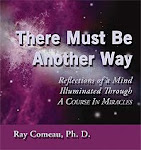It is simply miraculous that Jesus brought from out of time His Course in Miracles through the scribe, Helen Schucman. Though reluctant, she persevered over a seven-year period to write down in shorthand the words of A Course in Miracles. On a daily basis her colleague, Bill Thetford, took her transcription and typed it up into words and sentences and paragraphs. The prose and poetry of this masterpiece is impeccable, demonstrating that it could have come only from out of time.
Nevertheless, students occasionally joke about certain words and phrases because of their connotations in English. For example, Lesson 140, Only salvation can be said to cure, is usually called the “ham lesson” because cured ham is considered a delicacy. In the Reviews of Lessons 171-180, this phrase begins and ends the repetition of the daily Lessons, God is but Love, and therefore so am I, sometimes brings laughter because of the wordplay of “but” and “butt.”
Over the years, students have rolled their eyes when they came across the phrase, a screen of smoke, in Lesson 133, I will not value what is valueless.
All things are valuable or valueless,
worthy or not of being sought at all,
entirely desirable or
not worth the slightest effort to obtain.
Choosing is easy just because of this.
Complexity is nothing but a screen
of smoke, which hides the very simple fact
that no decision can be difficult.
What is the gain to you in learning this?
It is far more than merely letting you
make choices easily and without pain.
(W-p1.133.12)
Students, of course, think it should be “smoke screen” and smirk and say things like, “Well, after all, Jesus’ first language wasn’t English, but Aramaic.”
Finally, after all these years, I came across the phrase “screen of smoke” in another context, and I flashed on this phrase from the Course and saw the absolute precision of Jesus’ language. This epiphany occurred while reading an article in The New Yorker about ancient cave paintings in France and in Spain. Here are three paragraphs that provide a context for the insight.
During the Old Stone Age, between thirty-seven thousand and eleven thousand years ago, some of the most remarkable art ever conceived was etched or painted on the walls of caves in southern France and northern Spain. What those first artists invented was a language of signs for which there will never be a Rosetta stone; perspective, a technique that was not rediscovered until the Athenian Golden Age; and a bestiary of such vitality and finesse that, by the flicker of torchlight, the animals seem to surge from the walls. In the course of some twenty-five thousand years, the same animals—primarily bison, stags, aurochs, ibex, horses, and mammoths—recur in similar poses, illustrating an immortal story.
In the century since the modern study of caves began, specialists have tried to understand the culture that produced them. Of course, over the years, a number of theories have been developed. One group of specialists developed the theory that cave painting largely represents the experiences of shamans or initiates on a vision quest to the underworld. The caves themselves served as a gateway. Where the artists or their entourage left handprints, they were palping a living rock or summoning a life force beyond it.
Jean-Michel Geneste, a leonine man of fifty-nine with a silver mane, told me about an experiment that he had conducted at Lascaux in 1994. He decided to invite four elders of an Aboriginal tribe, the Nganinyins—hunter-gatherers from northwestern Australia—to visit the cave, and put them up in his house in the Dordogne. (Judith Thurman, First Impressions: What does the world’s oldest art say about us?, The New Yorker, June 23, 2008, p. 59)
And now here is the paragraph that brought into perspective the unerring accuracy of Jesus’ language.
Before visiting the caves, they first had to purify themselves, so they built a fire, and pulled some of their underarm hair out and burned it. Their own rituals involve traversing a screen of smoke—passing into another zone. When they entered the cave, they took a while to get their bearings. Yes, they said, it was an initiation site. The geometric signs, in red and black, reminded them of their own clan insignia, the animals and engravings of figures from their creative myths. (Thurman, p. 60)
There it is. Their rituals required traversing a screen of smoke—passing into another zone. In His Lesson, Jesus is teaching us how to pass from one world into another, passing from the false world to the true world.
There are no satisfactions in the world.
(W-p1.133.2:5)
He is expressing how easy it is to make the transition from valuing the valueless to valuing what is of value, passing in effect, from one zone to another, shifting from the false, egoic state to our true state of mind where only the truth is valued. To do that, we simply part the veil, move to another state; it is as simple as passing through a screen of smoke.
“Smoke screen” has a different connotation. It suggests “an action taken to mislead somebody or obscure something.”
Jesus shows us, however, that the ego’s complexity can be walked through as simply as we can walk through a thin screen of smoke, leaving behind the ego’s valueless state and entering into our true state of mind, the only state of any value, the only state there is.
Subscribe to:
Post Comments (Atom)

No comments:
Post a Comment